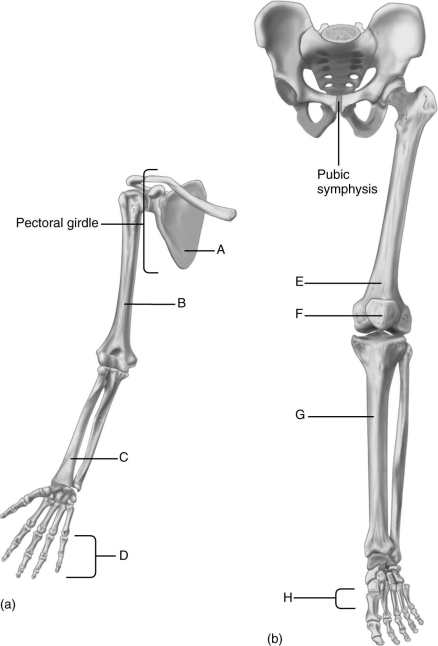Correct Answer

verified
Correct Answer
verified
Multiple Choice
In which of the following bones are the teeth anchored?
A) mandible and zygomatic bones
B) mandible and maxilla
C) maxilla and zygomatic bones
D) mandible and sphenoid bone
E) sphenoid bone and maxilla
Correct Answer

verified
Correct Answer
verified
Multiple Choice
Match the following. -vertebrae
A) carpal tunnel syndrome
B) flat bones
C) irregular bone
D) sinusitis
E) osteoporosis
F) long bone
G) sprain
H) short bone
I) arthritis
Correct Answer

verified
Correct Answer
verified
Multiple Choice
Arrange in the proper sequence the following events as they occur in the ossification of a long bone. 1) Chondroblasts die, and the surrounding matrix breaks down. 2) Osteoblasts secrete osteoid. 3) Blood vessels transport osteoblasts into the area to be ossified. 4) Chondroblasts create a model of long bones from cartilage. 5) Osteoblasts become osteocytes.
A) 3, 2, 5, 4, 1
B) 4, 1, 3, 2, 5
C) 4, 1, 5, 3, 2
D) 5, 2, 3, 1, 4
E) 3, 2, 1, 5, 4
Correct Answer

verified
Correct Answer
verified
Short Answer
As osteocytes become enclosed in small chambers called lacunae, they still can communicate via ________.
Correct Answer

verified
Correct Answer
verified
Multiple Choice
A typical long bone has an epiphysis at each end, which can be thought of as
A) yellow bone marrow.
B) a cylindrical hollow shaft.
C) a tough layer of connective tissue.
D) a site of water storage.
E) an enlarged knob.
Correct Answer

verified
Correct Answer
verified
Short Answer
Chondroblasts produce ________.
Correct Answer

verified
Correct Answer
verified
Multiple Choice
 Using the figure above, identify the bones of the appendicular skeleton.
-Label G represents the ________ bone.
Using the figure above, identify the bones of the appendicular skeleton.
-Label G represents the ________ bone.
A) humerus
B) patella
C) radius
D) metatarsals
E) phalanges
F) scapula
G) tibia
H) femur
Correct Answer

verified
Correct Answer
verified
Short Answer
Immovable joints such as those found between bones of the skull are ________ joints.
Correct Answer

verified
Correct Answer
verified
Multiple Choice
Which one of the following statements is TRUE regarding parathyroid hormone (PTH) ?
A) It stimulates the release of growth hormone.
B) It is released when blood calcium levels are high.
C) It has the same function as calcitonin.
D) It causes the breakdown of bone.
E) It causes decreased activity of osteoclasts.
Correct Answer

verified
Correct Answer
verified
Multiple Choice
Each of the following bones is part of the axial skeleton EXCEPT which one?
A) ribs
B) vertebrae
C) sternum
D) maxilla
E) clavicle
Correct Answer

verified
Correct Answer
verified
True/False
Individuals can prevent osteoporosis by including sufficient supplies of vitamin C and calcium in their diets and maintaining a consistent exercise program.
Correct Answer

verified
Correct Answer
verified
Multiple Choice
Which one of the following statements is TRUE regarding fibrous joints?
A) They are freely movable and can bend and rotate.
B) The bones are separated by a fluid-filled cavity that lubricates the joint.
C) Fibrous joints present at birth between bones of the skull develop into sutures in the adult.
D) The bones are held together by cartilage and tendons.
E) They include hinge joints and ball-and-socket joints.
Correct Answer

verified
Correct Answer
verified
Short Answer
The ________ bones are pierced by tiny openings through which the tear ducts drain.
Correct Answer

verified
Correct Answer
verified
Multiple Choice
Which one of the following disorders of the skeletal system results from the "wearing out" of the cartilage that covers the ends of bones?
A) bursitis
B) osteoarthritis
C) tennis elbow
D) rheumatoid arthritis
E) sinusitis
Correct Answer

verified
Correct Answer
verified
Showing 81 - 95 of 95
Related Exams